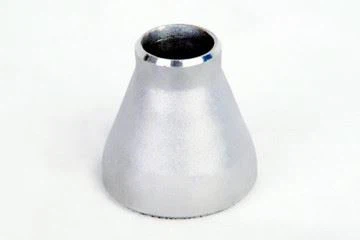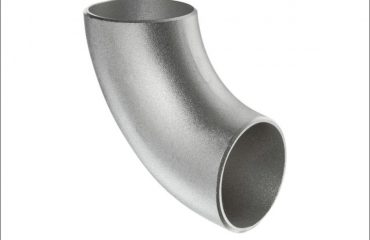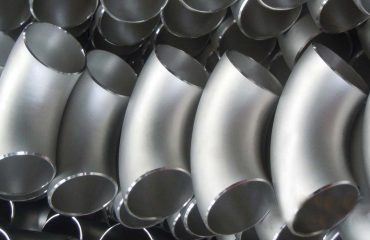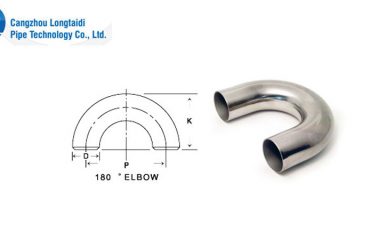
การเจาะลึกเกรดเฉพาะ
WP304 และ WP304H
WP304: เกรดนี้เป็นสแตนเลสที่นิยมใช้กันมากที่สุด, เป็นที่รู้จักในด้านความสามารถรอบด้านและความสมดุลของคุณสมบัติ. มีความทนทานต่อการกัดกร่อนในสภาพแวดล้อมบรรยากาศและสารกัดกร่อนหลายชนิดได้ดีเยี่ยม. คุณสมบัติทางกลที่ดีและความสามารถในการขึ้นรูปทำให้เหมาะสำหรับการใช้งานที่หลากหลาย, ตั้งแต่อุปกรณ์ครัวไปจนถึงการแปรรูปทางเคมี.
WP304H: WP304 รุ่นคาร์บอนสูง, WP304H ได้รับการออกแบบสำหรับการใช้งานที่อุณหภูมิสูง. ปริมาณคาร์บอนที่เพิ่มขึ้นช่วยเพิ่มความแข็งแรงที่อุณหภูมิสูงกว่า 500°C (932° F). การใช้งานทั่วไปได้แก่ส่วนประกอบหม้อไอน้ำและเครื่องแลกเปลี่ยนความร้อน.
WP309
สแตนเลส WP309 มีโครเมียมและนิกเกิลในระดับที่สูงกว่าเมื่อเทียบกับ WP304, ให้ความต้านทานต่อการเกิดออกซิเดชันที่เหนือกว่า. เกรดนี้มักใช้ในสภาพแวดล้อมที่มีอุณหภูมิสูงและมีสภาวะการกัดกร่อนอยู่ร่วมกัน, เช่นชิ้นส่วนเตาหลอม, ตัวออกซิไดซ์ความร้อน, และเครื่องแลกเปลี่ยนความร้อน.
WP310
WP310 เป็นอีกหนึ่งเกรดทนอุณหภูมิสูง, มีปริมาณโครเมียมและนิกเกิลสูงกว่า WP309. รักษาความต้านทานต่อการเกิดออกซิเดชันและการกัดกร่อนได้ดีเยี่ยมในสภาพแวดล้อมที่มีอุณหภูมิสูงถึง 1100°C (2012° F). การใช้งานทั่วไปรวมถึงส่วนประกอบของเตาหลอม, ตะกร้าบำบัดความร้อน, และอุปกรณ์แปรรูปทางเคมี.
WP316 และ WP316L
WP316: การรวมโมลิบดีนัมใน WP316 ช่วยเพิ่มความต้านทานต่อการกัดกร่อนแบบรูพรุนของคลอไรด์และการกัดกร่อนของรอยแยก, ทำให้เหมาะสำหรับสภาพแวดล้อมทางทะเลและทางเคมี. มักใช้ในอุปกรณ์แปรรูปยาและอาหาร, ตลอดจนการใช้งานสถาปัตยกรรมชายฝั่ง.
WP316L: รุ่นคาร์บอนต่ำของ WP316 ให้ความสามารถในการเชื่อมที่ดีขึ้น และลดความเสี่ยงของการตกตะกอนของคาร์ไบด์ระหว่างการเชื่อม. ทำให้เป็นตัวเลือกที่ต้องการสำหรับการใช้งานแบบเชื่อมในสภาพแวดล้อมที่รุนแรง, เช่นถังเคมีและระบบท่อส่งสารเคมี.
WP317L
สแตนเลส WP317L มีปริมาณโมลิบดีนัมสูงกว่า WP316, ให้ความต้านทานต่อการกัดกร่อนแบบรูพรุนและรอยแยกได้ดียิ่งขึ้น. มันถูกใช้ในสภาพแวดล้อมที่มีการกัดกร่อนสูง เช่น กระบวนการทางเคมี, petrochemical, และอุตสาหกรรมยา.
WP321
WP321 มีความเสถียรด้วยไทเทเนียม, ซึ่งป้องกันการเกิดโครเมียมคาร์ไบด์ที่อุณหภูมิสูง, จึงช่วยเพิ่มความต้านทานต่อการกัดกร่อนตามขอบเกรน. เหมาะสำหรับการใช้งานที่เกี่ยวข้องกับการให้ความร้อนอย่างต่อเนื่องและไม่ต่อเนื่อง, เช่นท่อร่วมไอเสียและส่วนประกอบด้านการบินและอวกาศ.
WP347
คล้ายกับ WP321, WP347 มีความเสถียร, แต่ด้วยโคลัมเบียม (ไนโอเบียม). เกรดนี้มีความทนทานต่อการกัดกร่อนตามขอบเกรนได้ดีเยี่ยม และมักใช้ในการแปรรูปทางเคมีที่อุณหภูมิสูงและการใช้งานด้านการผลิตไฟฟ้า.
WP904L
WP904L เป็นสเตนเลสออสเทนนิติกอัลลอยด์สูงที่มีความต้านทานการกัดกร่อนเป็นพิเศษ, โดยเฉพาะอย่างยิ่งกับสภาพแวดล้อมของกรดซัลฟิวริกและคลอไรด์. มีปริมาณนิกเกิลและโมลิบดีนัมสูง, พร้อมกับการเติมทองแดง, เพิ่มความต้านทานต่อการกัดกร่อนแบบรูพรุนและรอยแยก. การใช้งานทั่วไป ได้แก่ อุปกรณ์ระบายความร้อนด้วยน้ำทะเล, กระบวนการทางเคมี, และส่วนประกอบโรงกลั่นน้ำมัน.
สถานการณ์การใช้งานโดยละเอียด
กระบวนการทางเคมี
ในอุตสาหกรรมเคมี, ความต้านทานต่อกรดและคลอไรด์ต่างๆ เป็นสิ่งสำคัญ. เกรดเช่น WP316, WP316L, WP317L, และ WP904L เป็นที่ต้องการสำหรับความต้านทานการกัดกร่อนที่เหนือกว่า. วัสดุเหล่านี้ใช้ในเครื่องปฏิกรณ์, ถังเก็บ, และระบบท่อที่ต้องสัมผัสกับสารเคมีรุนแรงเป็นเรื่องปกติ.
อุตสาหกรรมน้ำมันและก๊าซ
ภาคน้ำมันและก๊าซต้องการวัสดุที่สามารถทนต่อแรงกดดันสูงได้, อุณหภูมิ, และสภาพแวดล้อมที่มีฤทธิ์กัดกร่อน. WP304H, WP309, WP310, และ WP347 มักใช้ในอุตสาหกรรมนี้. พบได้ในการใช้งาน เช่น ส่วนประกอบของโรงกลั่น, ท่อ, และอุปกรณ์ขุดเจาะนอกชายฝั่ง.
การใช้งานทางทะเล
สภาพแวดล้อมทางทะเลมีฤทธิ์กัดกร่อนสูง, โดยเฉพาะอย่างยิ่งเนื่องจากการมีอยู่ของคลอไรด์. WP316, WP316L, และ WP904L เหมาะอย่างยิ่งสำหรับสภาวะดังกล่าว. ใช้ในการต่อเรือ, โครงสร้างนอกชายฝั่ง, และโรงงานแยกเกลือ.
การผลิตไฟฟ้า
โรงไฟฟ้าต้องการวัสดุที่สามารถทนต่ออุณหภูมิและแรงกดดันสูงได้. WP321 และ WP347 เหมาะอย่างยิ่งสำหรับการใช้งานเหล่านี้เนื่องจากมีความเสถียรและทนทานต่อการกัดกร่อนตามขอบเกรน. ใช้ในส่วนประกอบหม้อไอน้ำ, แลกเปลี่ยนความร้อน, และชิ้นส่วนกังหัน.
อุตสาหกรรมอาหารและเครื่องดื่ม
ความต้านทานต่อสุขอนามัยและการกัดกร่อนเป็นสิ่งสำคัญยิ่งในอุตสาหกรรมอาหารและเครื่องดื่ม. โดยทั่วไปจะใช้ WP304 และ WP316 เนื่องจากไม่ทำปฏิกิริยากับสารอาหารและทำความสะอาดง่าย. การใช้งานรวมถึงอุปกรณ์แปรรูปอาหาร, ถังเก็บ, และท่อ.
สรุป
ตัวลดขนาดสเตนเลสสตีลที่เป็นไปตามเกรด ASTM A403 WP นำเสนอคุณสมบัติที่หลากหลายซึ่งปรับให้เหมาะกับความต้องการทางอุตสาหกรรมโดยเฉพาะ. การเลือกเกรดที่เหมาะสมขึ้นอยู่กับปัจจัยต่างๆ เช่น ความต้านทานการกัดกร่อน, ความยืดหยุ่นของอุณหภูมิ, คุณสมบัติทางกล, และความสามารถในการเชื่อม. การทำความเข้าใจคุณประโยชน์และการใช้งานเฉพาะตัวของแต่ละเกรดทำให้มั่นใจได้ถึงประสิทธิภาพสูงสุดและอายุการใช้งานที่ยาวนานของระบบท่อในอุตสาหกรรมต่างๆ.
อ้างอิง
- มาตรฐาน ASTM A403/A403M: ข้อกำหนดมาตรฐานสำหรับอุปกรณ์ท่อสเตนเลสออสเทนนิติกแบบดัด.
- เอเอสเอ็ม อินเตอร์เนชั่นแนล: คู่มือเหล็กกล้าไร้สนิม.
- เอ็นเออี อินเตอร์เนชั่นแนล: ข้อมูลเบื้องต้นเกี่ยวกับการกัดกร่อน: การแนะนำ.
- วรรณกรรมทางเทคนิค: คุณสมบัติของวัสดุและกระบวนการผลิตสำหรับตัวลดขนาดสเตนเลส.
- รายงานการตลาด: แนวโน้มและการคาดการณ์สำหรับอุตสาหกรรมเหล็กกล้าไร้สนิม.
เอกสารที่ครอบคลุมนี้ควรให้ความเข้าใจอย่างถ่องแท้เกี่ยวกับตัวลดขนาดสเตนเลสในเกรด ASTM A403 WP, แนวทางการเลือกและการประยุกต์ใช้วัสดุเหล่านี้ในบริบททางอุตสาหกรรมต่างๆ.
กระบวนการผลิตโดยละเอียด
เพื่อให้เข้าใจถึงความสามารถและข้อจำกัดของตัวลดขนาดสเตนเลส ASTM A403 WP อย่างครบถ้วน, จำเป็นอย่างยิ่งที่จะต้องเจาะลึกกระบวนการผลิตที่เกี่ยวข้อง. กระบวนการเหล่านี้มีอิทธิพลอย่างมากต่อคุณสมบัติทางกล, โครงสร้างจุลภาค, และโดยรวม คุณภาพ ของผลิตภัณฑ์ขั้นสุดท้าย.
การปลอม
การปลอม เป็นวิธีการทั่วไปที่ใช้ในการผลิตตัวลดขนาดสเตนเลส. กระบวนการนี้เกี่ยวข้องกับการให้ความร้อนเหล็กที่อุณหภูมิสูง จากนั้นจึงขึ้นรูปโดยใช้แรงอัด. การตีขึ้นรูปปรับปรุงโครงสร้างเกรน, ส่งผลให้คุณสมบัติทางกลดีขึ้น, รวมถึงความแข็งแกร่งและความเหนียว.
- การตีขึ้นรูปแบบเปิด: เกี่ยวข้องกับการเปลี่ยนรูปโลหะระหว่างแม่พิมพ์หลายตัวที่ไม่ได้ปิดล้อมวัสดุไว้อย่างสมบูรณ์. เหมาะสำหรับขนาดใหญ่, รูปร่างที่กำหนดเอง.
- การตีขึ้นรูปแบบปิด: ใช้แม่พิมพ์ที่ปิดล้อมวัสดุไว้อย่างสมบูรณ์, ช่วยให้ได้รูปทรงที่แม่นยำและสม่ำเสมอ. วิธีนี้เหมาะสำหรับการผลิตรีดิวเซอร์ขนาดเล็กในปริมาณมาก.
เครื่องจักรกล
เครื่องจักรกล มักใช้เพื่อให้ได้ขนาดสุดท้ายและความคลาดเคลื่อนที่จำเป็นสำหรับตัวลดขนาดสเตนเลส. กระบวนการนี้เกี่ยวข้องกับการเอาวัสดุออกจากชิ้นงานโดยใช้เครื่องมือตัด.
- การหมุน: ใช้สร้างชิ้นส่วนทรงกระบอกโดยการหมุนชิ้นงานกับเครื่องมือตัด.
- มิลลิ่ง: เกี่ยวข้องกับการใช้เครื่องมือตัดแบบหมุนเพื่อขจัดวัสดุและสร้างพื้นผิวเรียบหรือซับซ้อน.
- การเจาะและการกรีด: จำเป็นสำหรับการสร้างรูและเกลียวในตัวลดขนาด.
การรักษาความร้อน
การรักษาความร้อน กระบวนการมีความสำคัญอย่างยิ่งในการเพิ่มคุณสมบัติทางกลและความต้านทานการกัดกร่อนของตัวลดขนาดสเตนเลส. วิธีการบำบัดความร้อนทั่วไป ได้แก่:
- การหลอม: เกี่ยวข้องกับการทำความร้อนเหล็กจนถึงอุณหภูมิที่กำหนด จากนั้นจึงทำให้เย็นลงอย่างช้าๆ. กระบวนการนี้ช่วยลดความเครียดภายใน, ช่วยเพิ่มความเหนียว, และปรับโครงสร้างจุลภาค.
- การหลอมสารละลาย: เฉพาะกับสเตนเลสออสเทนนิติก, กระบวนการนี้จะละลายคาร์ไบด์ที่ตกตะกอน, เพิ่มความต้านทานการกัดกร่อน.
เชื่อม
เชื่อม มักจำเป็นต้องต่อข้อต่อลดสเตนเลสกับส่วนประกอบอื่นๆ ในระบบท่อ. กระบวนการเชื่อมจะต้องได้รับการควบคุมอย่างระมัดระวังเพื่อป้องกันปัญหาต่างๆ เช่น การตกตะกอนของคาร์ไบด์, ซึ่งสามารถลดความต้านทานการกัดกร่อนได้.
- ทีไอจี (ก๊าซเฉื่อยทังสเตน) เชื่อม: ให้การควบคุมที่แม่นยำและสูง-คุณภาพ รอยเชื่อม, ทำให้เหมาะสำหรับส่วนที่บางและการใช้งานที่สำคัญ.
- ฉัน (ก๊าซเฉื่อยของโลหะ) เชื่อม: ให้ความเร็วในการเชื่อมที่เร็วกว่าและเหมาะสำหรับส่วนที่หนากว่า.
การตกแต่งพื้นผิว
การตกแต่งพื้นผิว กระบวนการต่างๆ มีความสำคัญต่อการปรับปรุงรูปลักษณ์ภายนอก, ความต้านทานการกัดกร่อน, และความสะอาดของตัวลดสเตนเลส.
- การดองและการทู่: เกี่ยวข้องกับการกำจัดสิ่งปนเปื้อนบนพื้นผิวและตะกรันออกไซด์, ตามด้วยการทู่เพื่อฟื้นฟูชั้นโครเมียมออกไซด์ที่ป้องกัน.
- การขัดด้วยไฟฟ้า: กระบวนการไฟฟ้าเคมีที่ทำให้พื้นผิวเรียบและขัดเงา, เพิ่มความต้านทานการกัดกร่อนและลดความเสี่ยงของการปนเปื้อน.
การควบคุมและการทดสอบคุณภาพ
รับรองว่า คุณภาพ และประสิทธิภาพของตัวลดขนาดสเตนเลสเป็นสิ่งสำคัญยิ่ง. มีการนำมาตรการการทดสอบและการควบคุมคุณภาพต่างๆ มาใช้ตลอดกระบวนการผลิต.
การวิเคราะห์ทางเคมี
การวิเคราะห์ทางเคมี ตรวจสอบองค์ประกอบของสแตนเลส, รับรองว่าเป็นไปตามข้อกำหนดเกรดที่ระบุ. เทคนิคต่างๆ เช่น Optical Emission Spectroscopy (สศส) และเอ็กซ์เรย์เรืองแสง (เอ็กซ์อาร์เอฟ) มีการใช้กันทั่วไป.
การทดสอบทางกล
การทดสอบทางกล ประเมินความแข็งแกร่ง, ความเหนียว, และความเหนียวของวัสดุ. การทดสอบทั่วไปได้แก่:
- การทดสอบแรงดึง: วัดการตอบสนองของวัสดุต่อแรงดึง, ให้ข้อมูลเกี่ยวกับความแข็งแรงของผลผลิต, ความแข็งแรง, และการยืดตัว.
- การทดสอบความแข็ง: กำหนดความต้านทานของวัสดุต่อการเยื้องและการสึกหรอ.
- การทดสอบผลกระทบ: ประเมินความเหนียวของวัสดุ, โดยเฉพาะที่อุณหภูมิต่ำ.
การทดสอบแบบไม่ทำลาย (NDT)
การทดสอบแบบไม่ทำลาย วิธีการใช้ในการตรวจจับข้อบกพร่องที่พื้นผิวและใต้ผิวดินโดยไม่ทำลายวัสดุ. วิธีการ NDT ทั่วไป ได้แก่:
- การทดสอบอัลตราโซนิก (OUT): ใช้คลื่นเสียงความถี่สูงเพื่อตรวจจับข้อบกพร่องภายใน.
- การทดสอบภาพรังสี (RT): ใช้รังสีเอกซ์หรือรังสีแกมมาเพื่อเปิดเผยข้อบกพร่องภายใน.
- ย้อมทดสอบแทรกซึม (อพท): ใช้สำหรับตรวจจับรอยแตกร้าวและข้อบกพร่องบนพื้นผิว.
ตรวจสอบมิติ
ตรวจสอบมิติ ตรวจสอบให้แน่ใจว่าตัวลดตรงตามขนาดและความคลาดเคลื่อนที่ระบุ. เทคนิคต่างๆ เช่น เครื่องวัดพิกัด (ซีเอ็มเอ็ม) และคาลิเปอร์ที่ใช้กันทั่วไป.
บทสรุป
การเลือกและการใช้งานตัวลดขนาดสเตนเลส ASTM A403 WP จำเป็นต้องมีความเข้าใจเกรดต่างๆ อย่างถี่ถ้วน, คุณสมบัติของพวกเขา, และกระบวนการผลิตที่เกี่ยวข้อง. โดยคำนึงถึงปัจจัยต่างๆ เช่น ความต้านทานการกัดกร่อน, คุณสมบัติทางกล, และข้อกำหนดการใช้งานเฉพาะ, อุตสาหกรรมต่างๆ สามารถรับประกันประสิทธิภาพสูงสุดและอายุการใช้งานที่ยาวนานของระบบท่อของตนได้.
อ้างอิง
- มาตรฐาน ASTM A403/A403M: ข้อกำหนดมาตรฐานสำหรับอุปกรณ์ท่อสเตนเลสออสเทนนิติกแบบดัด.
- เอเอสเอ็ม อินเตอร์เนชั่นแนล: คู่มือเหล็กกล้าไร้สนิม.
- เอ็นเออี อินเตอร์เนชั่นแนล: ข้อมูลเบื้องต้นเกี่ยวกับการกัดกร่อน: การแนะนำ.
- วรรณกรรมทางเทคนิค: คุณสมบัติของวัสดุและกระบวนการผลิตสำหรับตัวลดขนาดสเตนเลส.
- รายงานการตลาด: แนวโน้มและการคาดการณ์สำหรับอุตสาหกรรมเหล็กกล้าไร้สนิม.
คู่มือที่ครอบคลุมนี้ควรให้ข้อมูลเชิงลึกที่มีคุณค่าเกี่ยวกับโลกที่ซับซ้อนของตัวลดขนาดสเตนเลส, ที่ช่วยในการคัดเลือก, แอพลิเคชัน, และการประกันคุณภาพของส่วนประกอบที่สำคัญเหล่านี้ในอุตสาหกรรมต่างๆ.




คุณจะต้องเป็น เข้าสู่ระบบ แสดงความคิดเห็น.